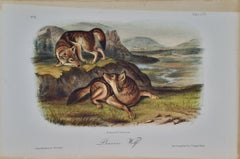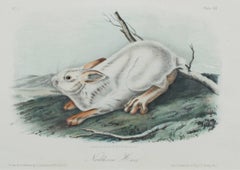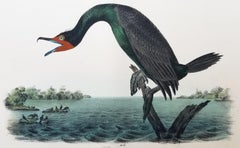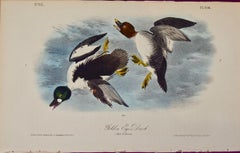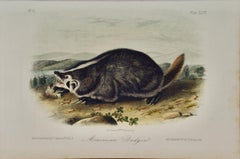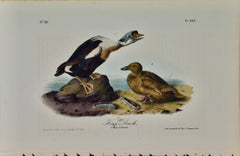Lithograph Animal Prints
to
2
73
1
7
Overall Width
to
Overall Height
to
81
77
58
48
46
4
77
4
51
30
71
52
12
10
9
8
6
5
4
4
4
4
4
3
3
3
3
3
3
3
81
20
20
5
5
5
50
81
Artist: John James Audubon
Medium: Lithograph
"Prairie Wolf": An Original Audubon 19th Century Hand-colored Lithograph
Located in Alamo, CA
This is an original John James Audubon hand-colored royal octavo lithograph entitled "Prairie Wolf", No. 15, Plate LXXI, 71 from Audubon's "Quadrupeds of North America". It was drawn...
Category
Mid-19th Century Naturalistic Lithograph Animal Prints
Materials
Lithograph
19th century color lithograph hare animal print wildlife
Located in Milwaukee, WI
"Northern Hare" is an original color lithograph by John James Audubon. This piece depicts a white rabbit in a cool green landscape.
5 3/4" x 7 3/4" art...
Category
1840s Other Art Style Lithograph Animal Prints
Materials
Lithograph
Florida Cormorant /// John James Audubon Ornithology Bird Art Natural History
Located in Saint Augustine, FL
Artist: John James Audubon (American, 1785-1851)
Title: "Florida Cormorant" (Plate 417, No. 84)
Portfolio: The Birds of America, First Royal Octavo Edition
Year: 1840-1844
Medium: Original Hand-Colored Lithograph on wove paper
Limited edition: approx. 1,200
Printer: John T. Bowen, Philadelphia, PA
Publisher: John James Audubon and J.B. Chevalier, New York, NY and Philadelphia, PA
Sheet size: 6.5" x 10.44"
Image size: 3.75" x 6.25"
Condition: Some minor discoloration upper center in margin. In excellent condition with strong colors
Notes:
Provenance: private collection - Cleveland, OH. Lithography and hand-coloring by American artist John T. Bowen (1801-c.1856). Comes from Audubon's famous seven volume portfolio "The Birds of America", First Royal Octavo Edition (1840-1844), which consists of 500 hand-colored lithographs.
Based on a composition painted in the Florida Keys on April 26, 1832, Audubon's forty-seventh birthday.
The double-crested cormorant (Nannopterum auritum) is a member of the cormorant family of water birds. It is found near rivers and lakes and in coastal areas and is widely distributed across North America, from the Aleutian Islands in Alaska down to Florida and Mexico. Measuring 70–90 cm (28–35 in) in length, it is entirely black except for a bare patch of orange-yellow facial skin and some extra plumage that it exhibits in the breeding season when it grows a double crest in which black feathers are mingled with white. Five subspecies are recognized. It mainly eats fish and hunts by swimming and diving. Its feathers, like all cormorants, are not waterproof, and it must dry them out after spending time in the water. Once threatened by the use of DDT, the numbers of this bird have increased markedly in recent years.
To make 'The Birds of America' more affordable and widely available, in 1839 John James Audubon began the first octavo edition, a smaller version of the folio which was printed and hand-colored by J. T. Bowen in Philadelphia. Employing a new invention, the camera lucida, the images were reduced in size, rendered in intermediate drawings by John James Audubon and his son John Woodhouse, and then drawn onto lithographic stones. These miniatures exhibit a remarkable amount of attention to quality and detail, as well as a meticulous fidelity to the larger works. Some compositional changes were made in order to accommodate the smaller format. Like the Havell edition, John James Audubon’s first...
Category
1840s Victorian Lithograph Animal Prints
Materials
Watercolor, Lithograph
Golden Eye Duck: an Original 1st Edition Hand Colored Audubon Bird Lithograph
Located in Alamo, CA
An original rare and extremely collectible first edition John James Audubon hand colored royal octavo lithograph entitled "Golden Eye Duck", No. 82, Plate 406, from Audubon's "Birds of America". It was lithographed, printed and colored by J. T. Bowen and published in Philadelphia between 1840-1844. It depicts male and female Golden Eye ducks in flight.
This original rare first edition hand colored Audubon bird lithograph is in excellent condition. The sheet measures 6.25" x 10". The original text pages, pages 362-366, from Audubon's publication are included.
John James Audubon (1785-1851) was a naturalist and artist. He was initially unsuccessful financially prior to the publication of his famous work “The Birds of America”, spending time in debtor’s prison, once stabbing a disgruntled investor in self-defense. However, his obsession with birds and art motivated him to persist in his goal of documenting every bird in America via his watercolor paintings and publishing his works for all to enjoy. Audubon's first illustrations were published in a large elephant folio size. Due to their expense they were purchased in rather small numbers by the wealthy. To reach a larger audience, Audubon, with the help of his sons and J. T. Bowen, published a smaller octavo sized lithograph version, which were much more affordable.
With the success of his bird projects, Audubon then turned his attention to four-legged animals. He explored the Missouri River in 1843 sketching the four-legged animals he encountered in their natural setting. His expedition covered some of the same regions recently explored by Lewis and Clark, traveling from present day Alaska to Mexico. Audubon realized that this was an opportunity to document these animals in the still relatively pristine American wilderness, before man encroached on their environment.
Between 1845 and 1848, Audubon and his sons John Woodhouse Audubon and Victor Gifford Audubon produced a set of elephant folio sized lithographs that were primarily engraved and hand colored by J. T. Bowen in Philadelphia. The publication, which included text descriptions of the animals was published 3 years before Audubon died. As with the birds, this was followed by a three-volume set of 155 octavo-sized plates entitled “The Quadrupeds of North America” completed and published by Audubon’s sons, John, Jr. and Victor.
Audubon prints continue to be popular and a wise investment. The double elephant folio set...
Category
Mid-19th Century Naturalistic Lithograph Animal Prints
Materials
Lithograph
American Badger: An Original 19th Century Audubon Hand-colored Lithograph
Located in Alamo, CA
This is an original 19th century John James Audubon hand colored lithograph entitled "American Badger", No. 10, Plate XLVII, 47, from Audubon's "Quadrupeds of North America", printed...
Category
Mid-19th Century Naturalistic Lithograph Animal Prints
Materials
Lithograph
"King Duck": An Original First Octavo Edition Audubon Hand-colored Lithograph
Located in Alamo, CA
This is an original John James Audubon hand-colored royal first octavo edition lithograph entitled "King Duck, 1. Male, 2. Female", No. 81, Plate 404, from A...
Category
Mid-19th Century Naturalistic Lithograph Animal Prints
Materials
Lithograph
Black Rat, Old & Young: A 1st Octavo Edition Audubon Hand-colored Lithograph
Located in Alamo, CA
This is an original 19th century 1st octavo edition John James Audubon hand-colored lithograph entitled "Black Rat, Old and Young", No. 5, Plate XXIII, 23, from Audubon's "Quadrupeds...
Category
Mid-19th Century Naturalistic Lithograph Animal Prints
Materials
Lithograph
Golden Winged Woodpecker by J.J. Audubon Bien Edition 1860
Located in Paonia, CO
The Golden Winged Woodpecker, Plate 273 Picus auratus, Linn. The current name, Northern Flicker, Colaptes auratus. is in good condition. The edges are ragged from age with small areas of paper missing in two places but only on the very edge.
The ” Birds of America” by John James...
Category
1860s Other Art Style Lithograph Animal Prints
Materials
Lithograph
Canada Grouse: An Original 19th C. Audubon 1st Ed. Hand-colored Bird Lithograph
Located in Alamo, CA
This is an original rare first octavo edition John James Audubon hand-colored lithograph entitled "Canada Grouse, 1. 2 Males, 3. Females, 4. Trillium pic...
Category
Mid-19th Century Naturalistic Lithograph Animal Prints
Materials
Lithograph
Hudsonian Godwit 19th C. 1st Octavo Edition Audubon Hand-colored Bird Lithograph
Located in Alamo, CA
This is an original 19th century John James Audubon hand-colored 1st octavo edition lithograph entitled "Hudsonian Godwit, 1. Male, 2. Female, Summer Plumage", No. 70, Plate 349 from...
Category
Mid-19th Century Naturalistic Lithograph Animal Prints
Materials
Lithograph
Hare Indian Dog: An Original 19th Century Audubon Hand-colored Lithograph
Located in Alamo, CA
This is an original 19th century John James Audubon hand-colored lithograph entitled "Hare Indian Dog", No. 27, Plate CXXXII, 132, from Audubon's "Quadruped...
Category
Mid-19th Century Naturalistic Lithograph Animal Prints
Materials
Lithograph
Original Audubon Hand Colored Lithograph of a "Canada Pouched Rat"
Located in Alamo, CA
An original John James Audubon hand colored lithograph entitled "Canada Pouched Rat", No. 9, Plate XLIV from John James Audubon's Quadrupeds of North America, published in Philadelph...
Category
Mid-19th Century Naturalistic Lithograph Animal Prints
Materials
Lithograph
Black-billed Cuckoo: An Original 1st Ed. Audubon Hand-colored Bird Lithograph
Located in Alamo, CA
This is an original 1st octavo edition John James Audubon hand-colored lithograph entitled "Black-billed Cuckoo, 1. Male, 2, Female, Magnolia Grandiflora", No. 56, Plate 276 from Audubon's "Birds of America, lithographed, printed and colored by J. T. Bowen and published in Philadelphia between 1840-1844. It depicts a female black-billed cuckoo perched on a branch of a magnolia tree reaching for a flying insect. The male appears to be in flight in front of magnolia leaves on the right, perhaps after the same insect. Magnolia flowers are depicted, as well.
This original 1st octavo edition hand-colored Audubon Black-billed Cuckoo lithograph is in excellent condition, other than a few tiny spots in the upper margin and a tiny faint spot in the lower inscription area. The sheet measures 6.5" high by 10.13" wide. The original text pages, 300-302, from Audubon's 19th century publication are included with the lithograph.
John James Audubon (1785-1851) was a naturalist and artist. He was initially unsuccessful financially prior to the publication of his famous work “The Birds of America”, spending time in debtor’s prison, once stabbing a disgruntled investor in self-defense. However, his obsession with birds and art motivated him to persist in his goal of documenting every bird in America via his watercolor paintings and publishing his works for all to enjoy. Audubon's first illustrations were published in a large elephant folio size. Due to their expense they were purchased in rather small numbers by the wealthy. To reach a larger audience, Audubon, with the help of his sons and J. T. Bowen, published a smaller octavo sized lithograph version, which were much more affordable.
With the success of his bird projects, Audubon then turned his attention to four-legged animals. He explored the Missouri River in 1843 sketching the four-legged animals he encountered in their natural setting. His expedition covered some of the same regions recently explored by Lewis and Clark, traveling from present day Alaska to Mexico. Audubon realized that this was an opportunity to document these animals in the still relatively pristine American wilderness, before man encroached on their environment.
Between 1845 and 1848, Audubon and his sons John Woodhouse Audubon and Victor Gifford Audubon produced a set of elephant folio sized lithographs that were primarily engraved and hand colored by J. T. Bowen in Philadelphia. The publication, which included text descriptions of the animals was published 3 years before Audubon died. As with the birds, this was followed by a three-volume set of 155 octavo-sized plates entitled “The Quadrupeds of North America” completed and published by Audubon’s sons, John, Jr. and Victor.
Audubon prints continue to be popular and a wise investment. The double elephant folio set...
Category
Mid-19th Century Naturalistic Lithograph Animal Prints
Materials
Lithograph
"Northern Meadow Mouse" an Audubon Hand Colored by J.T. Bowen Lithograph
Located in Alamo, CA
An original 19th century John James Audubon hand colored lithograph entitled "Northern Meadow Mouse", No. 26, Plate CXXIX, 129, from Audubon's "Quadrupeds of North America", printed ...
Category
Mid-19th Century Naturalistic Lithograph Animal Prints
Materials
Lithograph
Willet or Stone Curlew: A First Octavo Edition Audubon Hand-colored Lithograph
Located in Alamo, CA
This is an original John James Audubon hand-colored royal first octavo edition lithograph entitled "Semipalmated Snipe, Willet or Stone Curlew, 1. ...
Category
Mid-19th Century Naturalistic Lithograph Animal Prints
Materials
Lithograph
Long-billed Curlew (City of Charleston) /// Ornithology John James Audubon Bird
Located in Saint Augustine, FL
Artist: John James Audubon (American, 1785-1851)
Title: "Long-billed Curlew (City of Charleston)" (Plate 355, No. 71)
Portfolio: The Birds of America, First Royal Octavo Edition...
Category
1840s Victorian Lithograph Animal Prints
Materials
Watercolor, Lithograph
Yellow Shanks Snipe (South Carolina) /// Bird Ornithology John James Audubon
Located in Saint Augustine, FL
Artist: John James Audubon (American, 1785-1851)
Title: "Yellow Shanks Snipe (South Carolina)" (Plate 344, No. 69)
Portfolio: The Birds of America, First Royal Octavo Edition
Year: 1840-1844
Medium: Original Hand-Colored Lithograph on wove paper
Limited edition: approx. 1,200
Printer: John T. Bowen, Philadelphia, PA
Publisher: John James Audubon and J.B. Chevalier, New York, NY and Philadelphia, PA
Framing: Framed in a faux wood moulding with fabric matting and gold filet
Framed size: 11.25" x 14.25"
Sheet size: approx. 10" x 6.5"
Image size: 5.13" x 8.5"
Condition: Some wear to framing. In otherwise very good condition with strong colors
Notes:
Provenance: private collection - St. Louis, MO. Lithography and hand-coloring by American artist John T. Bowen (1801-c.1856). Comes from Audubon's famous seven volume portfolio "The Birds of America", First Royal Octavo Edition (1840-1844), which consists of 500 hand-colored lithographs.
Based on a composition probably painted near Charleston in 1832. The exceptionally beautiful depiction of the marshy habitat is the work of Audubon's assistant, George Lehman.
The lesser yellowlegs is a medium-sized shorebird. The genus name Tringa is the New Latin name given to the green sandpiper by Aldrovandus in 1599 based on Ancient Greek trungas, a thrush-sized, white-rumped, tail-bobbing wading...
Category
1840s Victorian Lithograph Animal Prints
Materials
Watercolor, Lithograph
Purple Martin Bien Ed. J.J. Audubon rare hand colored chromolithograph
Located in Paonia, CO
Two adult Purple Martins are feeding their two fledglings at the nest. This chromolithograph is from The Birds of America by John James Audubon and is ...
Category
Mid-18th Century Lithograph Animal Prints
Materials
Lithograph
Ivory Gull /// Ornithology Bird Audubon Seascape Beach Ocean Shorebird Shell
Located in Saint Augustine, FL
Artist: John James Audubon (American, 1785-1851)
Title: "Ivory Gull" (Plate 445, No. 89)
Portfolio: The Birds of America, First Royal Octavo Editi...
Category
1840s Victorian Lithograph Animal Prints
Materials
Watercolor, Lithograph
Booby Gannet /// Ornithology Bird Art John James Audubon Florida Keys Seascape
Located in Saint Augustine, FL
Artist: John James Audubon (American, 1785-1851)
Title: "Booby Gannet" (Plate 426, No. 86)
Portfolio: The Birds of America, First Royal Octavo Edition
Year: 1840-1844
Medium: Original Hand-Colored Lithograph on wove paper
Limited edition: approx. 1,200
Printer: John T. Bowen, Philadelphia, PA
Publisher: John James Audubon and J.B. Chevalier, New York, NY and Philadelphia, PA
Sheet size: 10.38" x 6.75"
Image size: 5.94" x 5.5"
Condition: Two small tears at top edge. In otherwise excellent condition with strong colors
Notes:
Provenance: private collection - Seattle, WA. Lithography and hand-coloring by American artist John T. Bowen (1801-c.1856). Comes from Audubon's famous seven volume portfolio "The Birds of America", First Royal Octavo Edition (1840-1844), which consists of 500 hand-colored lithographs.
Based on a composition painted May 14, 1832. Audubon wrote: "I am unable to find a good reason for those who have chosen to call these birds 'boobies'. Authors, it is true, generally represent them as extremely stupid; but to me the word is utterly inapplicable to any bird with which I am acquainted". The view of the Florida Keys is based on a drawing by George Lehman.
The bird family Sulidae comprises the gannets and boobies. Collectively called sulids, they are medium-large coastal seabirds that plunge-dive for fish and similar prey. The 10 species in this family are often considered congeneric in older sources, placing all in the genus Sula.
To make 'The Birds of America' more affordable and widely available, in 1839 John James Audubon began the first octavo edition, a smaller version of the folio which was printed and hand-colored by J. T. Bowen in Philadelphia. Employing a new invention, the camera lucida, the images were reduced in size, rendered in intermediate drawings by John James Audubon and his son John Woodhouse, and then drawn onto lithographic stones. These miniatures exhibit a remarkable amount of attention to quality and detail, as well as a meticulous fidelity to the larger works. Some compositional changes were made in order to accommodate the smaller format. Like the Havell edition, John James Audubon’s first...
Category
1840s Victorian Lithograph Animal Prints
Materials
Watercolor, Lithograph
Herring or Silvery Gull /// Ornithology Bird John James Audubon Seascape Beach
Located in Saint Augustine, FL
Artist: John James Audubon (American, 1785-1851)
Title: "Herring or Silvery Gull" (Plate 448, No. 90)
Portfolio: The Birds of America, First Royal Octavo Edition
Year: 1840-1844
Medi...
Category
1840s Victorian Lithograph Animal Prints
Materials
Watercolor, Lithograph
Key-West Dove /// Ornithology Bird John James Audubon Shorebird Flowers Plant
Located in Saint Augustine, FL
Artist: John James Audubon (American, 1785-1851)
Title: "Key-West Dove" (Plate 282, No. 57)
Portfolio: The Birds of America, First Royal Octavo Edition
Year: 1840-1844
Medium: Origin...
Category
1840s Victorian Lithograph Animal Prints
Materials
Watercolor, Lithograph
Glaucus Gull - Burgomaster /// Ornithology Bird John James Audubon Seascape Sky
Located in Saint Augustine, FL
Artist: John James Audubon (American, 1785-1851)
Title: "Glaucus Gull - Burgomaster" (Plate 449, No. 90)
Portfolio: The Birds of America, First Royal Octavo Edition...
Category
1840s Victorian Lithograph Animal Prints
Materials
Watercolor, Lithograph
Lithograph animal prints for sale on 1stDibs.
Find a wide variety of authentic Lithograph animal prints available on 1stDibs. While artists have worked in this medium across a range of time periods, art made with this material during the 21st Century is especially popular. If you’re looking to add animal prints created with this material to introduce a provocative pop of color and texture to an otherwise neutral space in your home, the works available on 1stDibs include elements of orange, blue, purple, yellow and other colors. There are many well-known artists whose body of work includes ceramic sculptures. Popular artists on 1stDibs associated with pieces like this include John James Audubon, Jean Jeacques Grandville, P. Mahler, and Alberto Mastroianni. Frequently made by artists working in the Modern, Contemporary, all of these pieces for sale are unique and many will draw the attention of guests in your home. Not every interior allows for large Lithograph animal prints, so small editions measuring 0.5 inches across are also available
